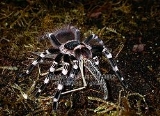
Brazilian whiteknee tarantula
Encyclopedia
The Whitebanded Tarantula (Acanthoscurria geniculata), is a species of tarantula
native to forests of Brazil
. It is commonly referred to as the whiteknee tarantula, giant whiteknee tarantula, giant white knee tarantula or Brazilian giant whiteknee tarantula as a homage to its brilliant black and white banded legs. This is a medium-large species, fast growing and taking up to 3-4 years to reach a mature legspan of 8.5 inches for females, slightly less for males.
It is a very fast-growing spider, and due to this, very hungry and greedy.
Although it can burrow, it often shows itself, and occasionally will climb up the walls of an enclosure in captivity.
A terrarium needs to be big, and wider than it is high (Minimum: 30 cm high, 40 cm wide, 40 cm long). A special substrate, or a mixture of clay, earth, and sand may be filled to several inches high so that the spider can make tunnels although it likely will not do so. A place to hide should be offered, for example a piece of wood. A bowl with water needs to be supplied. No hard or pointy objects should be placed next to the wall since the spider is an insecure climber and may fall. Should a whiteknee fall on a hard object, its abdomen may split open, which in most cases will lead to the spider's death. If found, a small wound can be treated with talcum powder to aid the clotting process or treated with a liquid bandage or superglue.
Whitebanded tarantulas have been much prized as pets, due to their size, hardiness, and striking coloration. They are moderately defensive, and their urticating hair
s can be quite irritating to human skin.
These spiders, like many un-domesticated pets, can bite when provoked. Fortunately because they have urticating hairs, biting is typically not their first line of defense. Their venom is not considered medically significant, but due to their large size the puncture damage can be extensive.
Tarantula
Tarantulas comprise a group of often hairy and often very large arachnids belonging to the family Theraphosidae, of which approximately 900 species have been identified. Some members of the same Suborder may also be called "tarantulas" in the common parlance. This article will restrict itself to...
native to forests of Brazil
Brazil
Brazil , officially the Federative Republic of Brazil , is the largest country in South America. It is the world's fifth largest country, both by geographical area and by population with over 192 million people...
. It is commonly referred to as the whiteknee tarantula, giant whiteknee tarantula, giant white knee tarantula or Brazilian giant whiteknee tarantula as a homage to its brilliant black and white banded legs. This is a medium-large species, fast growing and taking up to 3-4 years to reach a mature legspan of 8.5 inches for females, slightly less for males.
It is a very fast-growing spider, and due to this, very hungry and greedy.
Although it can burrow, it often shows itself, and occasionally will climb up the walls of an enclosure in captivity.
A terrarium needs to be big, and wider than it is high (Minimum: 30 cm high, 40 cm wide, 40 cm long). A special substrate, or a mixture of clay, earth, and sand may be filled to several inches high so that the spider can make tunnels although it likely will not do so. A place to hide should be offered, for example a piece of wood. A bowl with water needs to be supplied. No hard or pointy objects should be placed next to the wall since the spider is an insecure climber and may fall. Should a whiteknee fall on a hard object, its abdomen may split open, which in most cases will lead to the spider's death. If found, a small wound can be treated with talcum powder to aid the clotting process or treated with a liquid bandage or superglue.
Whitebanded tarantulas have been much prized as pets, due to their size, hardiness, and striking coloration. They are moderately defensive, and their urticating hair
Urticating hair
Urticating hairs, i.e. stinging hairs, are one of the primary defense mechanisms used by numerous plants, some New World tarantulas, and various lepidopteran caterpillars. Urtica is Latin for "nettle", and hairs that urticate are characteristic of this type of plant, and many other plants in...
s can be quite irritating to human skin.
These spiders, like many un-domesticated pets, can bite when provoked. Fortunately because they have urticating hairs, biting is typically not their first line of defense. Their venom is not considered medically significant, but due to their large size the puncture damage can be extensive.

